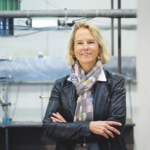More Time for People
Artificial Intelligence (AI) in the hospital still feels futuristic to many people. Yet it is now an important issue for the future of almost every area of medicine. For the past two and a half years, the Essen-based Institute for Artificial Intelligence in Medicine (IKIM) has been researching how the possibilities and limits of AI in medicine can be safely explored. By Katrin Koster
What can Artificial Intelligence do that years of medical experience can’t? Prof. Dr. Felix Nensa expected this question, and uses it to set one thing clear immediately, ‘AI helps doctors to be better and more efficient, but it doesn’t replace them.’ The radiologist heads one of at present four working groups with a total of about 140 scientists who are verifying exactly this in various projects and who want to translate it into everyday use.
At IKIM – close to the University Hospital campus – the young team works across the disciplines as part of the Medical Faculty of the UDE. They are all eager to explore new areas, but they are also well aware of the scepticism that machine-based diagnosis and treatment encounters.
‘We want to build trust and show how AI can make medicine more human again,’ says Nensa. More human, with the help of machines? For the professor, this is not a contradiction: ‘By automating routines and procedures, medical professionals can save valuable time. And they can then use it for personal consultations.’ Optimal use of resources also benefits the entire system financially. Without doubt an important aspect of modern hospital management. But how would it look in practice?

Three real-life examples
Scenario Nº 1: It’s a public holiday, the weather is fine, people are out and about, they get on their bikes, motorbikes or horses and – they’ll need more blood. This is because, statistically speaking, more accidents happen on holidays, increasing the demand for this precious resource. Where are how many blood reserves stored, what are their expiry dates and which blood groups are available? This IKIM project is not the only one that deals with huge amounts of data that can be evaluated at the push of a button. Blood donations can be optimally distributed and used in a timely manner; this helps with scheduled surgeries as well as when a hospital is experiencing bottlenecks. The idea is to use a new smartphone app to systematically motivate certain people to donate so that the exact blood group that is required will be available later on.
Scenario Nº 2: Patient John Doe is relieved; he can leave the hospital today, he’s just waiting for the hospital letter giving him the diagnosis and further treatment recommendations. Anyone who has ever experienced this knows how long such things can take. To avoid wasting precious time, AI is used in this case for automated letter writing: it brings together all essential information, and the medical staff check it once it’s done. ‘Ideally, the letter will be sent directly to the general practitioner. We’re also working on an AI that translates the content into a language that can be understood by laypeople,’ says Felix Nensa, rounding off the picture.
Scenario Nº 3: A transplant is due, a living liver donation. The consultant marks the area to be removed with millimetre accuracy – just enough so that the donor can get back on their feet as soon as possible and sufficient so that the organ fits into the new body and can function optimally. While performing all this precision work, the surgeon must not damage the hepatic vein. ‘A complex “paint-by-numbers” process that an AI can calculate and monitor much more effectively than a human. It can also evaluate images in a matter of seconds and provides crucial information about the planned intervention,’ points out Nensa. This, too, saves time and human labour.
Education is changing
melanoma. The numerous possibilities of Artificial Intelligence in medicine are being scientifically analysed, developed and rapidly made suitable for everyday use. With curiosity, optimism and always a large portion of scepticism. Always accompanied by the question of where the limits are. ‘We don’t just accept what the algorithms show us, we investigate thoroughly whether it is consistent – and where we should draw on our experience even more,’ emphasises Felix Nensa.
All these examples show that the answers discovered by IKIM are not ‘or’ but ‘and’. It’s about linking medical expertise and AI in the best possible way, cutting routines and, ultimately, creating more room for individualised medicine.
Institute for Artifificial Intelligence in Medicine (IKIM)
Established in February 2020, it is the first of its kind in Germany. It is part of the UDE Faculty of Medicine and the Essen University Hospital and is growing steadily. Currently, seven professorships have been newly established, with five already filled; there’s a DFG- funded research training group and four junior research groups. Approx. 140 people jointly work across the disciplines. They come from all around the world and contribute a great deal of expertise – ranging from computer science, through biochemistry and mathematics, to law, to name but a few.
The institute’s latest success is the KITE project, which is receiving 2.5 million euros from the European Union. This aims to develop a platform enabling AI-based tools to be introduced and applied rapidly in the hospital.
Another element is a sound education. Informatics and medicine have been working hand in hand for a long time, and so the medical staff of tomorrow must also familiarise themselves with the relevant software. ‘Otherwise, AI will become a flop,’ says Professor Nensa. ‘As a doctor, I should be able to explain to my patients why the data suggest exactly this operation and nothing else.’
Nensa understands the potential of this pioneering work: ‘Artificial Intelligence will change medicine – if we let it – positively. Because it recognises highly complex interconnections and patterns more easily. And this helps to make treatments far more individual and therefore more effective.’



